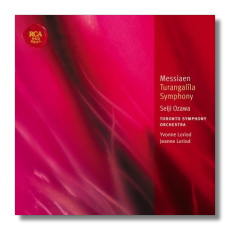
The Internet's Premier Classical Music Source
Related Links
- Messiaen Reviews
- Latest Reviews
- More Reviews
-
By Composer
-
Collections
DVD & Blu-ray
Books
Concert Reviews
Articles/Interviews
Software
Audio
Search Amazon
Recommended Links
Site News
 CD Review
CD Review
Olivier Messiaen

Turangalîla Symphony
Yvonne Loriod, piano
Jeanne Loriod, ondes Martenot
Toronto Symphony Orchestra/Seiji Ozawa
RCA Red Seal 82876-59418-2 ADD 76:59
This first North American recording of Olivier Messiaen's massive ode to Time and Love was made in December 1967 – an appropriate time in history, socio-politically speaking. (I don't suppose Spiro Agnew was a fan of Turangalîla, unfortunate man!) Ozawa had not yet taken up his post as Music Director of the Boston Symphony Orchestra, the ensemble that actually premièred this symphony in 1949, but certainly the planets and stars were coming into alignment during those heady times!
Since 1967, there have been several excellent recordings of Turangalîla – some received the explicit approval of the composer himself. So where does that leave Ozawa and his Canadians? Is this budget-priced reissue – its first in the United States – merely a bit of nostalgia for erstwhile hippies who have long since traded in their VW bugs for IRAs? It is still viable?
In France and Poland, respectively, Myung-Wha Chung and Antoni Wit have surpassed the standards of orchestral playing that Ozawa achieved in Toronto. Perhaps the comparison is unfair – about three decades separate the present recording and Chung's, Messiaen's music has become more familiar, and, arguably, today's orchestral musicians are better technicians than they were in the 1960s. (That doesn't mean that they play better, necessarily!) At the same time, Ozawa and his orchestra find (or perhaps fail to avoid!) a primitivism in this score which eludes Chung, Wit, and other well-groomed successors. They are a little more cautious (for example, in the last movement), and just a little less coherent, perhaps. Theirs is a Turangalîla constructed not from tiny crystals, but from rocks and boulders. Is this what Messiaen wanted? Well, bear in mind that the pianist on this recording is Madame Messiaen herself, and that her sister Jeanne is playing the ondes Martenot. What is presented here is probably very close to what the composer intended in 1967, that era's limitations taken into consideration. Creators keep an ideal in their heads (not necessarily a static one), and while it is possible to come closer and closer to it, it's seldom to possible to reach it.
As part of RCA Red Seal's new "Classic Library" series, this recording has been digitally remastered using state-of-the-art 96kHz/24-bit technology. The results definitely blow away the original LPs! I never suspected that there was so much detail here.
The Classic Library series contains both analogue and digital recordings – many of them classics in their day. The only downside, to my mind, is the rather blah cover design.
Copyright © 2004, Raymond Tuttle


















